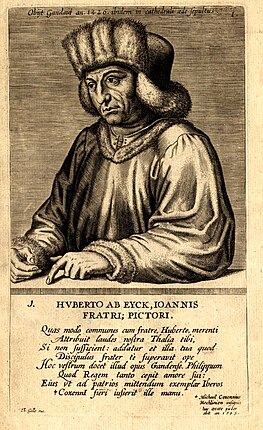Hubert van Eyck

Hubert van Eyck (Dutch pronunciation:
Life and career
He was probably born in Maaseik, in what is now the Belgian province of Limburg, into a family in the gentry.
As the name was not a very common one, he is probably the "Magister Hubertus, Pictor" recorded as having been paid in 1409 for panels in the church of Onze Lieve Vrouwe,
Around the time of his settlement, or shortly afterward, he began his only surviving documented work, the Ghent Altarpiece in St Bavo's. However, the painting was not finished until six years after his death, in 1432, so the degree to which the surviving altarpiece reflects his work, rather than that of Jan who took it over, remains much discussed. An inscription on the frame, which was destroyed in the beeldenstorm in 1566, stated that Hubert van Eyck "maior quo Nemo reports" (greater than anyone) started the altarpiece, but that Jan van Eyck – calling himself "arte Secundus" (second-best in the art) – completed it in 1432.[2]
Writing in 1933, art historian Bryson Burroughs, who at that time attributed to Hubert the Crucifixion and Last Judgement diptych, describing him as "the fountainhead of northern painting", suggests he did the underdrawing for the Ghent Altarpiece with Jan painting in after his brother's death;[2] some form of this view remains common among specialists. Modern scientific investigation reveals various changes between the finished work and the lower painted levels and the underdrawing. Today the inscription is often regarded as an overgenerous fraternal tribute.[1] Given the circumstances, the Ghent Altarpiece is a difficult work to use for comparison when assessing other attributions, especially as several other artists from the brothers' workshops probably worked on it as well.[3]

The town
Legacy
The division of surviving works between Hubert, early Jan van Eyck, and other painters has been the subject of great debate among art historians, involving the Ghent Altarpiece, the many different hands that can be detected in the
Notes
- ^ Old sources follow Karel van Mander (d. 1606), who gives 1366 as his year of birth, but this is now thought very unlikely. The modern estimate is based on working backward from the documented mentions of him as a "master".
References
- ^ a b c d e f g van Buren.
- ^ a b Burroughs 1933.
- ^ Snyder 1985, pp. 90–97; Harbison 1991, pp. 194–195.
- ^ a b van Buren; Snyder 1985, p. 90.
- ^ "Web Gallery of Art: EYCK, Hubert van".
- ^ Weale, Frances (1903). Hubert and John van Eyck. New York: Longmans. p. 4.
Sources
- Burroughs, Bryson (November 1933). "A Diptych by Hubert van Eyck". The Metropolitan Museum of Art Bulletin. 28 (11, part 1): 184–193.
- van Buren, Anne Hagopian. "Eyck, van family". Grove Art Online. Oxford University Press. Retrieved 9 December 2012 – via Oxford Art Online.
- Harbison, Craig (1991). Jan van Eyck, The Play of Realism. London: Reaktion Books. ISBN 0948462183.
- Snyder, James (1985). Northern Renaissance Art. Harry N. Abrams. ISBN 0136235964.
External links
- Crowe, Joseph Archer (1911). . Encyclopædia Britannica. Vol. 10 (11th ed.). pp. 90–91.
- Entry for Hubert van Eyck on the Union List of Artist Names
- Hubert van Eyck at Artcyclopedia
- Hubert Van Eyck biography at Web Gallery of Art
